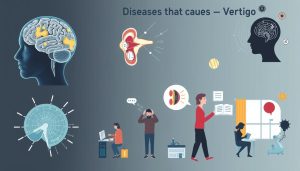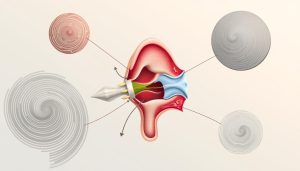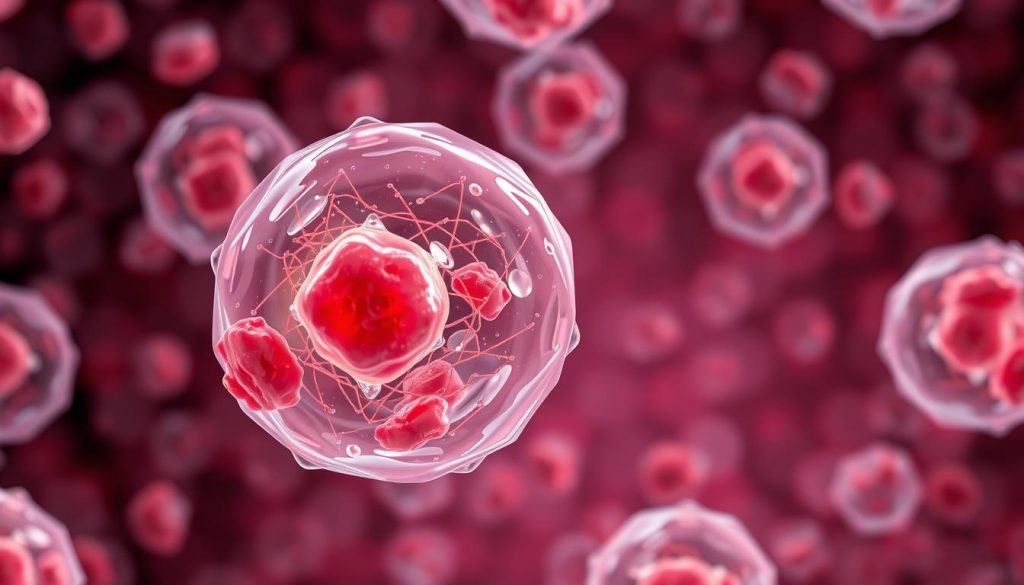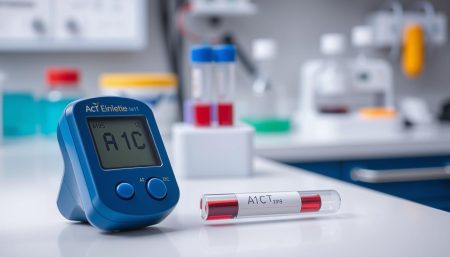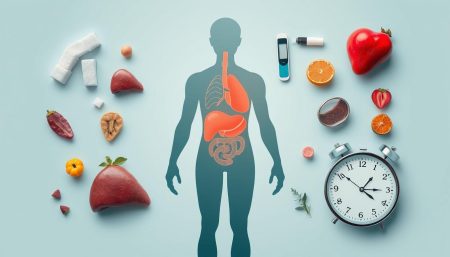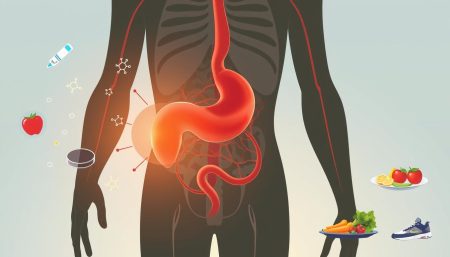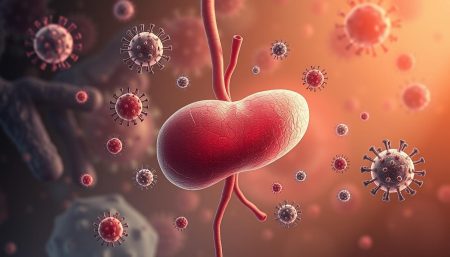The rise in type 2 diabetes is a major health issue. This guide aims to explain the complex biological and physiological processes behind type 2 diabetes progression. We want to help patients, doctors, and anyone interested understand diabetic pathophysiology better.
We’ll look at how genes, lifestyle, and metabolic problems work together to cause this disease. By exploring type 2 diabetes, we hope to give you the knowledge to manage, prevent, and care for it.
Introduction to the Pathophysiology of Diabetes Mellitus Type 2
To understand diabetes mellitus type 2, we must explore its pathophysiology. This knowledge helps us see how different factors contribute to the disease’s risk and progression.
The Definition and Prevalence of Type 2 Diabetes
Type 2 diabetes is a common condition caused by insulin resistance and beta-cell failure. Studies show it’s becoming more common, which is a big concern. This increase is linked to lifestyle and aging, making it important to talk about how it develops.
Basic Concepts of Pathophysiology in Diabetes
The journey to type 2 diabetes starts long before symptoms appear. Insulin resistance and beta-cell dysfunction are key. Knowing these helps us understand the disease’s complex mechanisms.
Genetics, environment, and lifestyle play big roles in type 2 diabetes. These factors make the disease complex. Early detection and prevention are key.
The following statistics show the growing problem of type 2 diabetes. They stress the need for urgent action:
| Year | Prevalence in Adults | Projected Figures |
|---|---|---|
| 2020 | 10.5% | N/A |
| 2025 | Estimated 11% | Increased Risk Factors Noted |
| 2030 | Projected 12% | Possible Public Health Interventions |
This data is a call to action. It highlights the need for ongoing research and public health efforts to fight this growing epidemic.
Understanding Type 2 Diabetes
Learning about type 2 diabetes is key to understanding it better. Doctors say it’s caused by a mix of genes, environment, and body chemistry. This shows why we need to know a lot about it.
Characterizing Type 2 Diabetes in the Medical Community
Doctors see type 2 diabetes as a unique condition. It’s marked by insulin resistance and a decrease in beta-cell function. To diagnose it, they look at blood sugar levels, HbA1c percentages, and symptoms.
Common Misconceptions About Type 2 Diabetes
Many think type 2 diabetes only affects older, overweight people. But, it’s also found in young adults and kids. It’s important to clear up myths like ‘eating too much sugar causes diabetes’.
Diabetes Type 2 Pathogenesis
Understanding diabetes type 2 pathogenesis means looking at how genes, environment, and lifestyle affect glucose use. This change is key in how the body uses insulin, leading to type 2 diabetes progression.
Type 2 diabetes often starts with insulin resistance. This is when the body’s cells don’t respond well to insulin. The pancreas then makes more insulin, leading to exhaustion and dysfunction of the beta-cells.
- Insulin resistance buildup – Often linked to obesity, physical inactivity, and diet.
- Genetic predisposition – A hereditary factor that increases susceptibility to diabetes.
- Persistent hormonal changes – Stress and pregnancy can also influence glucose metabolism.
Type 2 diabetes doesn’t happen suddenly. It develops as the body’s demand for insulin grows. Inflammation and cytokines from fat also make insulin resistance worse, leading to high blood sugar.
| Stage | Glucose Level | Beta-Cell Function | Insulin Sensitivity Level |
|---|---|---|---|
| Early | Normal to slightly elevated | High compensatory insulin secretion | Mildly decreased |
| Intermediate | Elevated fasting glucose | Starting to decline | Significantly decreased |
| Advanced | Consistently high | Significantly impaired | Severely decreased |
Understanding this path is key to catching and treating diabetes early. Changes in lifestyle and medical care are vital in managing and possibly reversing type 2 diabetes.
Insulin Resistance and Its Role in Type 2 Diabetes
Insulin resistance is a key part of type 2 diabetes. It’s a big challenge in understanding and managing this disease. The causes of type 2 diabetes are many, but insulin resistance plays a big role.
The Mechanism of Insulin Resistance
Insulin resistance happens when cells in muscles, fat, and the liver don’t respond well to insulin. They can’t easily take up glucose from the blood. This makes the pancreas produce more insulin, leading to more glucose management problems. This is how type 2 diabetes starts.
Factors Contributing to Insulin Resistance
Many things can lead to insulin resistance. These include genetics and lifestyle choices. Diet, lack of exercise, and being overweight, mainly around the belly, are big factors.
| Factor | Description | Impact on Insulin Sensitivity |
|---|---|---|
| Diet | High intake of sugars and fats | Decreases insulin sensitivity |
| Physical Inactivity | Lack of regular exercise | Reduces muscle glucose uptake |
| Obesity | Excess body fat, specially abdominal | Associated with increased insulin resistance |
Knowing about these factors and how they affect insulin resistance helps us understand type 2 diabetes better. It also shows us ways to prevent and manage it.
Beta-Cell Dysfunction in Type 2 Diabetes
Understanding beta-cell dysfunction is key to knowing how type 2 diabetes works. These mechanisms are vital for the disease’s growth and for finding ways to lessen its effects.
The Life Cycle of Beta Cells
Beta cells in the pancreas make insulin, which controls blood sugar. Their life is shaped by genes and the environment. When beta cells don’t work right, they can’t make enough insulin, leading to type 2 diabetes.
Genetic and Environmental Impact on Beta-Cell Health
Genes and the environment both affect beta-cell health. Genes can cause beta-cell problems, making diabetes more likely. Bad diets and not moving enough can hurt beta cells, making diabetes worse.
The table below shows how genes and the environment affect beta cells and type 2 diabetes.
| Factor | Impact on Beta-Cell Function | Consequences for Type 2 Diabetes |
|---|---|---|
| Genetic Mutations | Alter beta-cell growth or insulin synthesis | Higher susceptibility to beta-cell dysfunction |
| Obesity | Inflammatory cytokines impair beta-cell function | Increased insulin resistance and beta-cell stress |
| Physical Inactivity | Decreased insulin sensitivity in peripheral tissues | Greater demand on beta-cells, accelerating dysfunction |
| Poor Diet | Excessive demand on beta-cells due to high blood glucose | Exhaustion of beta-cells leading to dysfunction |
Knowing how genes and the environment affect beta cells and diabetes can help us find better ways to prevent and treat type 2 diabetes. This could lead to better management and even reversing the disease.
Diabetes 2 Mechanisms: The Role of Genetics and Lifestyle
Understanding type 2 diabetes involves looking at genetics and lifestyle. These two areas work together, affecting how the disease develops. This complex interaction is key to understanding diabetes 2 mechanisms.
Genetics play a big role in type 2 diabetes. Some genes make it harder for the body to use insulin. But, lifestyle choices also matter a lot. They can either speed up or slow down the disease.
Lifestyle factors like diet, exercise, and weight are things we can change. They are very important in managing and preventing type 2 diabetes. How we live can greatly affect our risk and how well we manage the disease.
This part looks at how lifestyle changes can impact type 2 diabetes. We focus on diet and exercise:
- Eating foods high in fiber and low in sugar can help control blood sugar and weight.
- Staying active improves insulin use and reduces fat, both important in preventing type 2 diabetes.
Understanding diabetes 2 mechanisms shows that it’s not just one thing. It’s a mix of genetics and lifestyle, like diet and exercise. This mix is very important.
| Lifestyle Factor | Improvement in Diabetes Risk |
|---|---|
| Increased Physical Activity | Reduces risk by up to 30% |
| Healthy Balanced Diet | Reduces risk by up to 25% |
| Weight Management | Reduces risk by up to 40% |
The connection between genetics and lifestyle changes shows how complex diabetes 2 mechanisms are. By working on both, we can manage or even stop type 2 diabetes.
Metabolic Abnormalities in Type 2 Diabetes
Type 2 diabetes causes big problems with how our cells work. Two main issues are glucotoxicity and lipotoxicity. Both have big effects on our bodies.
The Glucotoxicity Phenomenon
Glucotoxicity happens when blood sugar gets too high. It can cause serious problems for people with type 2 diabetes. It makes it hard for the pancreas to make insulin and makes tissues less responsive to insulin.
Lipotoxicity and its Consequences
Lipotoxicity is when too many lipids build up in places they shouldn’t. This can hurt cells and even kill them. It mainly affects the liver, muscles, and pancreas, which are key for handling fats and sugars.
| Metabolic Factor | Impact on Type 2 Diabetes |
|---|---|
| Glucotoxicity | Impairs insulin secretion, increases insulin resistance |
| Lipotoxicity | Causes cellular dysfunction, exacerbates insulin resistance |
The Impact of Obesity on Type 2 Diabetes Development
Obesity and type 2 diabetes have a strong connection that affects health worldwide. This part looks at how extra weight leads to type 2 diabetes. It focuses on how it affects insulin use and fat tissue function.
Exploring the Link Between Obesity and Insulin Sensitivity
Obesity is closely tied to lower insulin sensitivity, a key sign of type 2 diabetes. As weight goes up, the body’s insulin use goes down. This often leads to insulin resistance.
This resistance makes the pancreas work harder to make more insulin. If it can’t keep up, diabetes may follow.
Adipose Tissue Function in Diabetes Mellitus Type 2
Adipose tissue does more than just store fat. It’s key in hormone functions that affect insulin use and glucose. In obesity, adipose tissue doesn’t work right.
This leads to more free fatty acids and inflammatory cytokines. These things make insulin action worse.
| Condition | Impact on Insulin Sensitivity | Changes in Adipose Tissue Function |
|---|---|---|
| Normal Weight | High Insulin Sensitivity | Normal Lipid Metabolism and Hormone Secretion |
| Obesity | Decreased Insulin Sensitivity | Increased Inflammation, Impaired Lipid Metabolism |
Inflammation and its Connection to Type 2 Diabetes Progression
The connection between inflammation and type 2 diabetes is key to understanding the disease. Chronic inflammation harms the metabolism of those with type 2 diabetes. It affects many biological pathways and makes the disease worse.
This part looks at how inflammatory mediators like cytokines harm insulin signaling and β-cell function. These are critical for managing type 2 diabetes. Inflammation is not just a result but also a cause of insulin resistance, leading to type 2 diabetes.
- Understanding the triggers and sources of inflammation in diabetes.
- Evaluating the impact of chronic inflammation on insulin resistance.
- Exploring possible ways to reduce inflammation in diabetic patients.
Metabolic factors and immune responses interact, making inflammation worse. This creates a cycle that worsens the disease. It’s important to find ways to lower inflammation to slow or reverse type 2 diabetes progression.
Research also looks into medicines that target inflammation in diabetes. This shows a new way to manage inflammation and type 2 diabetes. Such treatments could be a big step forward in diabetes care, showing the need for a complete approach.
Causes of Type 2 Diabetes: Environmental vs. Genetic Factors
Understanding the causes of type 2 diabetes is complex. It involves looking at how genes and environment interact. This mix shapes why some people get diabetes and others don’t, even if they live similar lives.
Genes can make some people more likely to get type 2 diabetes. But, it’s usually the environment that starts the disease. Here’s how each part plays a role:
- Genetic Factors: Family history is key, with genes affecting insulin.
- Environmental Factors: What we eat, how active we are, and toxins matter a lot.
| Factor Type | Examples | Impact on Diabetes Risk |
|---|---|---|
| Genetic | Family history, gene mutations | High |
| Environmental | Poor diet, sedentary lifestyle | Modifiable risk factors |
The way these factors work together is key to understanding causes of type 2 diabetes. For example, someone with a genetic risk might avoid diabetes with a healthy lifestyle. This shows we can make a difference.
In short, both environment and genes matter in diabetes mellitus type 2 etiology. Knowing this helps us create ways to prevent and treat the disease.
The Role of Diet and Nutrition in Type 2 Diabetes Etiology
Diet and nutrition are key in preventing and managing Type 2 Diabetes. What we eat affects our blood sugar and metabolic health. This can change our risk and how the disease progresses.
Understanding the Glycemic Index
The glycemic index (GI) shows how foods raise blood sugar. High-GI foods raise it fast, worsening diabetes symptoms. Low-GI foods release glucose slowly, helping control blood sugar.
Nutritional Strategies for Managing Diabetes Type 2
Managing Type 2 Diabetes through nutrition is critical. Eating the right balance of nutrients and choosing low-GI foods can help. Here are important dietary tips:
- Focus on Fiber: Foods high in fiber help control blood sugar and keep you full, aiding in weight control.
- Choose Healthy Fats: Omega-3 fatty acids from fish and flaxseed fight inflammation and protect the heart.
- Monitor Protein Intake: Enough protein keeps muscle mass, vital for metabolic health.
- Limited Processed Foods: Cutting down on processed and sugary foods reduces glucose spikes and boosts insulin sensitivity.
Following these nutritional tips can help manage diabetes and even prevent it in those at risk.
Physical Activity and its Effects on Diabetes Type 2 Development
The link between physical activity and diabetes type 2 development is well-studied. Studies show that regular exercise can greatly affect this condition. It helps prevent type 2 diabetes and manage it if it’s already present.
Physical activity boosts insulin sensitivity and helps burn calories. These are key for controlling blood sugar and avoiding obesity. These benefits are vital for diabetes prevention and management. Here are some ways exercise impacts diabetes:
- Increases muscle glucose uptake, lowering blood sugar.
- Improves metabolic function, often impaired in diabetes.
- Helps with weight loss and maintenance, important for diabetes management.
- Reduces visceral fat, which increases diabetes risk.
Adding structured exercise to your life can improve insulin sensitivity and metabolic health. Here’s a table showing how different exercises affect diabetes type 2 development:
| Type of Exercise | Benefits |
|---|---|
| Aerobic Exercise | Improves heart and circulatory health, lowers blood glucose |
| Strength Training | Increases muscle mass, better glucose management, and burns more calories |
| Flexibility Exercises | Improves mobility, reduces stress, indirectly helps with glucose control |
Using these exercises effectively can significantly improve diabetes control or prevention. Research shows that adding moderate to vigorous physical activity daily is a key strategy in diabetes prevention.
Diabetic Pathophysiology: The Chronic Nature of Type 2 Diabetes
The study of diabetic pathophysiology sheds light on the lasting effects of Type 2 diabetes. It shows how important chronic diabetes management is. This management helps build a strong health base for those dealing with Type 2 diabetes.
Long-term Complications of Type 2 Diabetes
It’s key for both patients and doctors to know about long-term diabetes complications. These issues include heart disease, nerve damage, eye problems, and kidney issues. They pose big challenges for people living with Type 2 diabetes over time.
- Cardiovascular disease: increased risk of heart attacks and strokes.
- Neuropathy: loss of sensation in extremities, leading to injuries unnoticed by patients.
- Retinopathy: possible severe vision loss and blindness.
- Nephropathy: kidney damage that can lead to kidney failure needing dialysis.
Monitoring and Managing Chronic Symptoms
Managing Type 2 diabetes is a long-term effort. It involves constant checks and adjustments to lifestyle and treatment. Here are some important steps to manage this condition:
- Regular blood glucose monitoring to avoid hypoglycemic and hyperglycemic episodes.
- Consistent medical check-ups to assess and mitigate the progression of diabetes-related complications.
- Adherence to a well-constructed diet plan to manage blood sugar levels and promote overall health.
- Physical activity tailored to individual capabilities and health status.
Continuous efforts in chronic diabetes management and understanding diabetic pathophysiology are essential. They help lessen the impact of complications and improve life quality for those with Type 2 diabetes.
Medications and Therapeutic Approaches in Type 2 Diabetes
Exploring Type 2 diabetes medications and therapeutic approaches is key. It shows how these fit into diabetes treatment advancements. We see the latest treatments and the new ideas in this field.
Current Pharmacological Treatments for Type 2 Diabetes
There are many medicines for type 2 diabetes. Each targets a different part of the disease. Metformin is well-known for lowering blood sugar without causing weight gain.
Newer drugs like SGLT2 inhibitors and GLP-1 receptor agonists are also important. They help control blood sugar and can even help with weight loss and heart health. For example, Ozempic helps with glucose and weight.
Future Directions in Diabetes Treatment
The future of type 2 diabetes treatment looks bright. New research is focusing on fixing damaged pancreas cells and gene editing. These could lead to a cure, not just treatment.
Technology is also playing a big role in diabetes care. Things like continuous glucose monitors and smart insulin pumps are coming. They promise better care and a better life for people with diabetes.
With new medicines and treatment plans, the future for type 2 diabetes is hopeful. It’s moving towards more complete and focused therapeutic approaches.
Preventing Type 2 Diabetes Through Early Detection and Lifestyle Intervention
Type 2 diabetes is a growing health concern worldwide. Early detection and lifestyle changes are key to preventing it. By catching prediabetes early and making lifestyle changes, we can stop Type 2 diabetes before it starts.
Importance of Prediabetes Recognition
Prediabetes is a warning sign before Type 2 diabetes. It means blood sugar levels are a bit high but not high enough to be called diabetes. Spotting prediabetes early is vital for stopping Type 2 diabetes in its tracks.
Many people with prediabetes don’t know they have it. This is why teaching about its signs and risks is so important. Knowing about prediabetes leads to more monitoring and better health.
Lifestyle Intervention Programs and their Success Rates
Making lifestyle changes is key to preventing diabetes. This includes eating better, exercising more, and managing weight. Programs that focus on these areas have shown great success in preventing Type 2 diabetes in people with prediabetes.
- Diet: Eating less sugar and more fiber is important.
- Exercise: Aim for 150 minutes of moderate exercise each week.
- Weight Management: Losing 5-7% of body weight can greatly reduce risk.
Studies worldwide have shown that these interventions can cut diabetes risk by 40-70%. These results show how effective lifestyle changes can be in preventing Type 2 diabetes.

Educational and Support Resources for Better Diabetes Management
Managing Type 2 diabetes can be tough, but there are many diabetes management resources to help. The American Diabetes Association offers diabetes education programs. These cover diet, exercise, and blood sugar monitoring.
These programs give patients the knowledge to make better health choices. This knowledge helps them take charge of their health and lifestyle.
Living with diabetes is not just physical; it’s also emotional and psychological. Community support groups, both online and in-person, are vital. They let people share their experiences and get support.
These groups help build a sense of community. They motivate people to stick to their management plans. They also offer comfort and advice, helping those who feel alone.
Education is key to managing diabetes well. It helps patients stay informed about new research and treatments. By using these resources, people with diabetes can better manage their condition. This reduces the risk of complications and improves their life quality.
FAQ
Q: What is the pathophysiology of diabetes mellitus type 2?
A: Diabetes mellitus type 2 is caused by insulin resistance and beta-cell dysfunction. Insulin resistance happens when cells don’t take up glucose well. This is because they don’t respond to insulin.
As the condition worsens, the pancreas’s beta cells also fail. They can’t produce enough insulin. This leads to high blood glucose levels.
Q: How does type 2 diabetes develop?
A: Type 2 diabetes comes from a mix of genetics and lifestyle. Poor diet, lack of exercise, and obesity are key factors. These lead to insulin resistance and high blood glucose.
Q: What are common misconceptions about type 2 diabetes?
A: Many think type 2 diabetes is not serious and can be controlled by diet alone. But it’s a complex condition needing lifestyle changes, medication, and monitoring. It’s not just for overweight people.
Q: Can genetic factors alone cause type 2 diabetes?
A: Genetics are important, but they’re not the only cause. Lifestyle choices and environment also play a big role. Together, they determine your risk for type 2 diabetes.
Q: How does obesity affect the development of type 2 diabetes?
A: Obesity increases insulin resistance, a key factor in type 2 diabetes. Belly fat is linked to more insulin resistance and inflammation. It also releases hormones that harm glucose metabolism.
Q: How do metabolic abnormalities like glucotoxicity and lipotoxicity contribute to diabetes mellitus type 2?
A: Glucotoxicity and lipotoxicity harm cells and worsen insulin resistance. They also hurt insulin production in the pancreas. This makes diabetes mellitus type 2 worse.
Q: Why is understanding the glycemic index important in managing diabetes type 2?
A: Knowing the glycemic index is key for managing diabetes type 2. It shows how fast foods raise blood sugar. Eating low-GI foods helps control blood sugar levels.
Q: What role does inflammation play in the progression of type 2 diabetes?
A: Inflammation is linked to type 2 diabetes. It causes insulin resistance and harms beta cells. Obesity, bad diet, and lack of exercise can trigger inflammation.
Q: Are there any effective lifestyle intervention programs for preventing type 2 diabetes?
A: Yes, programs that change diet, increase activity, and help with weight loss work. The Diabetes Prevention Program (DPP) is an example. It helps prevent type 2 diabetes in high-risk people.
Q: What educational and support resources are available for people with type 2 diabetes?
A: Many resources help those with type 2 diabetes. The American Diabetes Association offers educational materials. There are also support groups, self-management programs, and online forums. They provide nutrition advice and emotional support.




